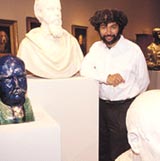| |
|
 |
 |
 |
 |
In conversation with Fred Wilson, April 1997.
Extract
James Putnam: What is it about museums that motivates or inspires your work?
Fred Wilson: From working in museums in various capacities - as an administrator, curator, free-lance educator, technician and museum guard I became aware of how these spaces convey ideas about culture. Especially at the large museums I became interested in the meanings they communicate but don’t talk about. The architecture and arrangement of the displays reveal a very specific notion about the cultures and people they are presenting. This is never discussed for the viewer and I only became aware of it because I was working at several different institutions at once, with very different ways of displaying things ranging from a Natural History to an Art Museum. Of course it matters how old the institution is - long established museums often convey ideas that contemporary curators no longer adhere to but the design of the building still tends to speak the views of an earlier time. This is really what interests me a great deal about museums.
JP: Do you think by striving to be impartial about the presentation of their collections museums succeed in avoiding potential cultural issues?
FW: I feel that museum professionals try to be impartial but to my mind there’s no way that they can be neutral. Just by attempting this they’re avoiding what they’re really thinking so by not being fully aware of what they’re presenting in an ideological way then they are not completely in control of the ideology.
JP: I know you’re interested in the acquisition history of museum objects. Do you think it’s related in some way to their presentation?
FW: Since a museum often focuses on the scientific it overlooks the historical, political ramifications of that object being in the collection. In many instances it’s politically expedient for the museum to disregard because the history may be a little murky, yet behind the scenes, they are always thinking about these issues. In general when it gets to the public’s interaction with the object, this history is either very veiled or masked. I think that many people who run collections or work with them tend not to be worried about the public so much. It’s certainly something I think about a lot because mostly I am the public and that’s my way of interacting with material. Even though I’m on this other side, sometimes by organising materials in museums, I just think greater thought can be put towards that.
JP: Because of their scientific nature museums do have a tendency to depersonalise everything and mummies are perhaps the most extreme example. It tends to get overlooked that much of their collections are composed of what were once peoples’ personal possessions and I know that your work often addresses this issue.
FW: Yes my whole desire is not to change museum practise but to make museums aware of what they do and what they are and how they relate to how their own culture is. I really do personalise everything - actually I did a piece with several vitrines in a regular gallery space with skeletons in them and the only label they had in them was: ‘someone’s mother’,’ someone’s father’, ’someone’s sister’, ‘someone’s brother’. Certainly in the U.S. we have all these native American skeletons that were collected around the turn of the century and depersonified in that way and now native Americans want them back. I try to make people aware that there’s other ways of viewing these things and question them for themselves.
JP: Let’s talk about your interest in museum furniture like display cases, mounts and labels.
FW: Because I’ve looked at a lot of different museums they really fascinate me. I don’t know how important it is but the early mounts really affect the object more directly - they put a hole in it so that you can attach it to the wall, or write on it in an irreversible way. Little by little, mounts and furniture are now not only affecting the object less but are less visible to the viewer. Although I haven’t fully understood what all this means, it is an interesting parallel to me that early on, things from other places and other cultures were modified or even damaged in that way and certainly at time when, lets say, cultural understanding was not at its peak, cultures were also being damaged. There is an emphasis in the United States on open-ness and freedom of access but this disguises barriers which are invisible but no less real. I find that interesting and I’d really like to look a little more deeply at that. Also how museum mounts, particularly the early mounts, where hand labour was readily available, are now from our vantage point, endowed with more individual character. We don’t have that any longer and it’s much more impersonal in the way we interact with the label making.
|
|
 |
 |
Fred Wilson

|
 |
 |
|
|
|